#niepokalanow
Text


St. Maximillian Kolbe the ‘Martyr of Auschwitz’, Polish priest who was known by the Nazis at Auschwitz as Prisoner 16670, voluntarily took the place of a stranger who was condemned to forced starvation.
Artwork by Pennsylvania sacred artist, Neilson Carlin.

THE STORY OF MAXIMILIAN KOLBE (AND WHY IT MATTERS NOW, MORE THAN EVER)
By 1938, Father Kolbe was presciently convinced that the Nazis were going to seize Poland. As the Nazis approached in 1939, Father Kolbe sent away almost all the friars, but Father Kolbe chose to stay behind with three dozen friars, and Niepokalanow was essentially converted to a hospital for wounded Polish soldiers.
The Nazis rolled their tanks into Poland on Sept. 1 and the town of Niepokalanow was bombed on Sept. 7. Yet Father Kolbe remained in place. Not only that, but with the Nazis figuratively, if not almost literally, breathing down his neck, he continued to publish materials critical of the Nazis.
The Nazis had seen enough of his writings that illustrated the evils and lies of Nazism, and on February 17, 1941, Father Kolbe was picked up and arrested. On May 28, he was sent to his final earthly destination: Auschwitz.
In July, the Nazis discovered that a man had escaped. The Nazis had a procedure for punishing the remaining prisoners after an escape: ten men would be starved to death. A German officer named Karl Fritsch gleefully chose the ten men who were standing in ranks. When one of these men, Franciszek Gajowniczek, pleaded, “My wife and children,” Father Maximilian Kolbe broke ranks and made a plea of his own: “I am a Catholic priest. I want to die for that man; I am old; he has a wife and children.”
Father Kolbe’s wish was granted, and he was led away to die naked in a dark cellar.
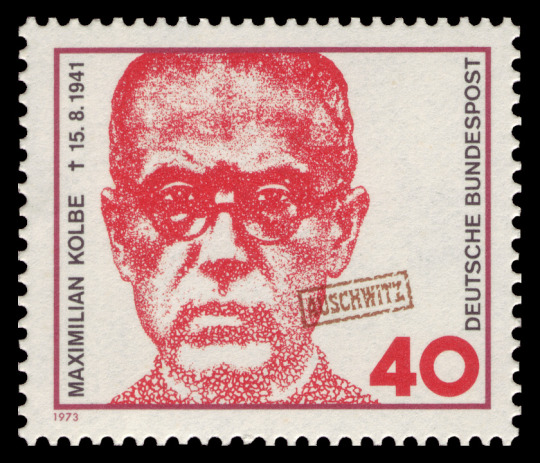

St. Maximillian is the patron saint of families, prisoners, journalists, political prisoners, drug addicts and the pro-life movement. St. John Paul II declared him to be “the patron saint of our difficult century.”
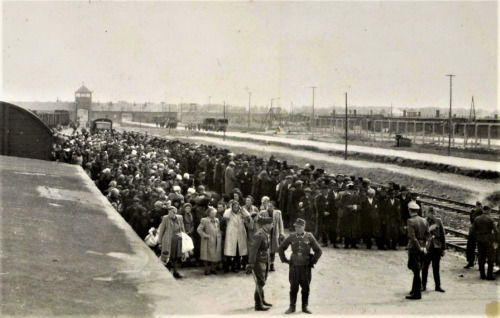
With men on one side, and women and children on the other, the selection process of who will live and who will be sent to the gas chambers begins. In the background can be seen the main gate of the Auschwitz II–Birkenau camp. May 27, 1944.
They call him the Martyr of Auschwitz, but we shouldn't forget that there were thousands & thousands of martyrs at Auschwitz...
#holocaust#auschwitz#st maximilian kolbe#kolbe#st maximillian kolbe#patron saints#father kolbe#martyr of auschwitz#cliff clavin
136 notes
·
View notes
Text
Today the Church remembers the 108 Blessed Polish Martyrs.
Orate pro nobis.
The 108 Blessed Polish Martyrs were Roman Catholic Christians in Poland killed during World War II by the Nazis, either in the concentration camps or by mass slaughter on the streets. The group comprises 3 bishops, 79 priests, 7 male religious, 8 female religious, and 11 lay people. There are two parishes named for the 108 Martyrs of World War II in Powiercie in Koło County, and in Malbork, Poland.
The 108 Blessed Martyrs were beatified on 13 June 1999 by Pope John Paul II in Warsaw, Poland.
List of Martyrs
Bishops
1. Antoni Julian Nowowiejski (1858–1941 KL Soldau), bishop
2. Leon Wetmański (1886–1941 KL Soldau), bishop
3. Władysław Goral (1898–1945 KL Sachsenhausen), bishop
Priests
1. Adam Bargielski, priest from Myszyniec (1903–1942 KZ Dachau)
2. Aleksy Sobaszek, priest (1895–1942 KL Dachau)
3. Alfons Maria Mazurek, Carmelite friar, prior, priest (1891–1944, shot by the Gestapo)
4. Alojzy Liguda, Society of the Divine Word, priest (1898–1942 KL Dachau)
5. Anastazy Jakub Pankiewicz, Franciscan friar, priest (1882–1942 KL Dachau)
6. Anicet Kopliński, Capuchin friar, priest in Warsaw (1875–1941)
7. Antoni Beszta-Borowski, priest, dean of Bielsk Podlaski (1880–1943, shot near Bielsk Podlaski)
8. Antoni Leszczewicz, Marian Father, priest (1890–1943, burnt to death in Rosica, Belarus)
9. Antoni Rewera, priest, dean of the Cathedral Chapter in Sandomierz (1869–1942 KL Dachau)
10. Antoni Świadek, priest from Bydgoszcz (1909–1945 KL Dachau)
11. Antoni Zawistowski, priest (1882–1942 KL Dachau)
12. Bolesław Strzelecki, priest (1896–1941 KL Auschwitz)
13. Bronisław Komorowski, priest (1889–22 March 1940 KL Stutthof)
14. Dominik Jędrzejewski, priest (1886–1942 KL Dachau)
15. Edward Detkens, priest (1885–1942 KL Dachau)
16. Edward Grzymała, priest (1906–1942 KL Dachau)
17. Emil Szramek, priest (1887–1942 KL Dachau)
18. Fidelis Chojnacki, Capuchin friar, priest (1906–1942, KL Dachau)
19. Florian Stępniak, Capuchin friar, priest (1912–1942 KL Dachau)
20. Franciszek Dachtera, priest (1910–23 August 1942 KL Dachau)
21. Franciszek Drzewiecki, Orionine Father, priest (1908–1942 KL Dachau); from Zduny, he was condemned to heavy work in the plantation of Dachau. While he was bending over tilling the soil, he adored the consecrated hosts kept in a small box in front of him. While he was going to the gas chamber, he encouraged his companions, saying "We offer our life for God, for the Church and for our Country".
22. Franciszek Rogaczewski, priest from Gdańsk (1892–1940, shot in Stutthof or in Piaśnica, Pomerania)
23. Franciszek Rosłaniec, priest (1889–1942 KL Dachau)
24. Henryk Hlebowicz, priest (1904–1941, shot at Borisov in Belarus)
25. Henryk Kaczorowski, priest from Włocławek (1888–1942)
26. Henryk Krzysztofik, religious priest (1908–1942 KL Dachau)
27. Hilary Paweł Januszewski, religious priest (1907–1945 KL Dachau)
28. Jan Antonin Bajewski, Conventual Franciscan friar, priest (1915–1941 KL Auschwitz); of Niepokalanow. These were the closest collaborators of St Maximilian Kolbe in the fight for God's cause and together suffered and helped each other spiritually in their offering their lives at Auschwitz
29. Jan Franciszek Czartoryski, Dominican friar, priest (1897–1944)
30. Jan Nepomucen Chrzan, priest (1885–1942 KL Dachau)
31. Jerzy Kaszyra, Marian Father, priest (1910–1943, burnt to death in Rosica, Belarus)
32. Józef Achilles Puchała, Franciscan friar, priest (1911–1943, killed near Iwieniec, Belarus)
33. Józef Cebula, Missionary Oblate, priest (23 March 1902 – 9 May 1941 KL Mauthausen)[
34. Józef Czempiel, priest (1883–1942 KL Mauthausen)
35. Józef Innocenty Guz, Franciscan friar, priest (1890–1940 KL Sachsenhausen)
36. Józef Jankowski, Pallotine, priest (1910 born in Czyczkowy near Brusy, Kashubia (died 16 October 1941 in KL Auschwitz beaten by a kapo)
37. Józef Kowalski, Salesian, priest (1911–1942) , priest beaten to death on 3 July 1942 in the KL Auschwitz concentration camp
38. Józef Kurzawa, priest (1910–1940)
39. Józef Kut, priest (1905–1942 KL Dachau)
40. Józef Pawłowski, priest (1890–9 January 1942 KL Dachau)
41. Józef Stanek, Pallottine, priest (1916–23 September 1944, murdered in Warsaw)
42. Józef Straszewski, priest (1885–1942 KL Dachau)
43. Karol Herman Stępień, Franciscan friar, priest (1910–1943, killed near Iwieniec, Belarus)
44. Kazimierz Gostyński, priest (1884–1942 KL Dachau)
45. Kazimierz Grelewski, priest (1907–1942 KL Dachau)
46. Kazimierz Sykulski, priest (1882–1942 KL Auschwitz)
47. Krystyn Gondek, Franciscan friar, priest (1909–1942 KL Dachau)
48. Leon Nowakowski, priest (1913–1939)
49. Ludwik Mzyk, Society of the Divine Word, priest (1905–1940)
50. Ludwik Pius Bartosik, Conventual Franciscan friar, priest (1909–1941 KL Auschwitz); of Niepokalanow. These were the closest collaborators of St Maximilian Kolbe in the fight for God's cause and together suffered and helped each other spiritually in their offering their lives at Auschwitz
51. Ludwik Roch Gietyngier, priest from Częstochowa (1904–1941 KL Dachau)
52. Maksymilian Binkiewicz, priest (1913–24 July 1942, beaten, died in KL Dachau)
53. Marian Gorecki, priest (1903–22 March 1940 KL Stutthof)
54. Marian Konopiński, Capuchin friar, priest (1907–1 January 1943 KL Dachau)
55. Marian Skrzypczak, priest (1909–1939 shot in Plonkowo)
56. Michał Oziębłowski, priest (1900–1942 KL Dachau)
57. Michał Piaszczyński, priest (1885–1940 KL Sachsenhausen)
58. Michał Woźniak, priest (1875–1942 KL Dachau)
59. Mieczysław Bohatkiewicz, priest (1904–4 March 1942, shot in Berezwecz)
60. Narcyz Putz, priest (1877–1942 KL Dachau)
61. Narcyz Turchan, priest (1879–1942 KL Dachau)
62. Piotr Edward Dankowski, priest (1908–3 April 1942 KL Auschwitz)
63. Roman Archutowski, priest (1882–1943 KL Majdanek)
64. Roman Sitko, priest (1880–1942 KL Auschwitz)
65. Stanisław Kubista, Society of the Divine Word, priest (1898–1940 KL Sachsenhausen)
66. Stanisław Kubski, priest (1876–1942, prisoner in KL Dachau, killed in Hartheim near Linz)
67. Stanisław Mysakowski, priest (1896–1942 KL Dachau)
68. Stanisław Pyrtek, priest (1913–4 March 1942, shot in Berezwecz)
69. Stefan Grelewski, priest (1899–1941 KL Dachau)
70. Wincenty Matuszewski, priest (1869–1940)
71. Władysław Błądziński, Michaelite, priest (1908–1944, KL Gross-Rosen)
72. Władysław Demski, priest (1884–28 May 1940, KL Sachsenhausen)
73. Władysław Maćkowiak, priest (1910–4 March 1942 shot in Berezwecz)
74. Władysław Mączkowski, priest (1911–20 August 1942 KL Dachau)
75. Władysław Miegoń, priest, commander lieutenant (1892–1942 KL Dachau)
76. Włodzimierz Laskowski, priest (1886–1940 KL Gusen)
77. Wojciech Nierychlewski, religious, priest (1903–1942, KL Auschwitz)
78. Zygmunt Pisarski, priest (1902–1943)
79. Zygmunt Sajna, priest (1897–1940, shot at Palmiry, near Warsaw)
Religious brothers
1. Brunon Zembol, friar (1905–1942 KL Dachau)
2. Grzegorz Bolesław Frąckowiak, Society of the Divine Word friar (1911–1943, guillotined in Dresden)
3. Józef Zapłata, friar (1904–1945 KL Dachau)
4. Marcin Oprządek, friar (1884–1942 KL Dachau)
5. Piotr Bonifacy Żukowski, friar (1913–1942 KL Auschwitz)
6. Stanisław Tymoteusz Trojanowski, friar (1908–1942 KL Auschwitz)
7. Symforian Ducki, friar (1888–1942 KL Auschwitz)
Nuns and religious sisters
1. Alicja Maria Jadwiga Kotowska, sister, based on eye-witness reports comforted and huddled with Jewish children before she and the children were executed (1899–1939, executed at Piaśnica, Pomerania)
2. Ewa Noiszewska, sister (1885–1942, executed at Góra Pietrelewicka near Slonim, Belarus)
3. Julia Rodzińska, Dominican sister (1899–20 February 1945, KL Stutthof); she died having contracted typhoid serving the Jewish women prisoners in a hut for which she had volunteered.
4. Katarzyna Celestyna Faron (1913–1944, KL Auschwitz); (1913–1944), had offered her life for the conversion of an Old Catholic bishop Władysław Faron (no relation). She was arrested by the Gestapo and condemned to Auschwitz camp. She put up heroically with all the abuses of the camp and died on Easter Sunday 1944. The bishop later returned to the Catholic Church).
5. Maria Antonina Kratochwil, SSND nun (1881–1942) died as a result of the torture she endured while imprisoned in Stanisławów.
6. Maria Klemensa Staszewska (1890–1943 KL Auschwitz)
7. Marta Wołowska (1879–1942, executed at Góra Pietrelewicka near Slonim, Belarus)
8. Mieczysława Kowalska, sister (1902–1941, Soldau concentration camp in Działdowo)
Roman Catholic laity
1. Bronisław Kostkowski, alumnus (1915–1942 KL Dachau)
2. Czesław Jóźwiak (1919–1942, guillotined in a prison in Dresden)
3. Edward Kaźmierski (1919–1942, guillotined in a prison in Dresden)
4. Edward Klinik (1919–1942, guillotined in a prison in Dresden)
5. Franciszek Kęsy (1920–1942, guillotined in a prison in Dresden)
6. Franciszek Stryjas (1882–31 July 1944, Kalisz prison)
7. Jarogniew Wojciechowski (1922–1942, guillotined in a prison in Dresden)
8. Marianna Biernacka (1888–13 July 1943), executed instead of her pregnant daughter-in-law Anna, offered her life for her and her unborn grandchild)
9. Natalia Tułasiewicz (1906–31 March 1945, died in KL Ravensbrück)
10. Stanisław Starowieyski (1895–1941 in KL Dachau)
11. Tadeusz Dulny, alumnus (1914–1942 KL Dachau)
Almighty God, by whose grace and power your Holy Martyrs of Poland triumphed over suffering and were faithful even to death: Grant us, who now remember them in thanksgiving, to be so faithful in our witness to you in this world, that we may receive with them the crown of life; through Jesus Christ our Lord, who lives and reigns with you and the Holy Spirit, one God, forever and ever. Amen.
(Fr. Józef Kowalski, priest beaten to death on 3 July 1942 in the KL Auschwitz concentration camp)
(Sr. Alicja Jadwiga Kotowska, a nun killed protecting a group of Jewish children in 1939 in the mass murders in Piaśnica)

#father troy beecham#christianity#jesus#saints#god#salvation#peace#martyrs#faith#christian persecution
39 notes
·
View notes
Text
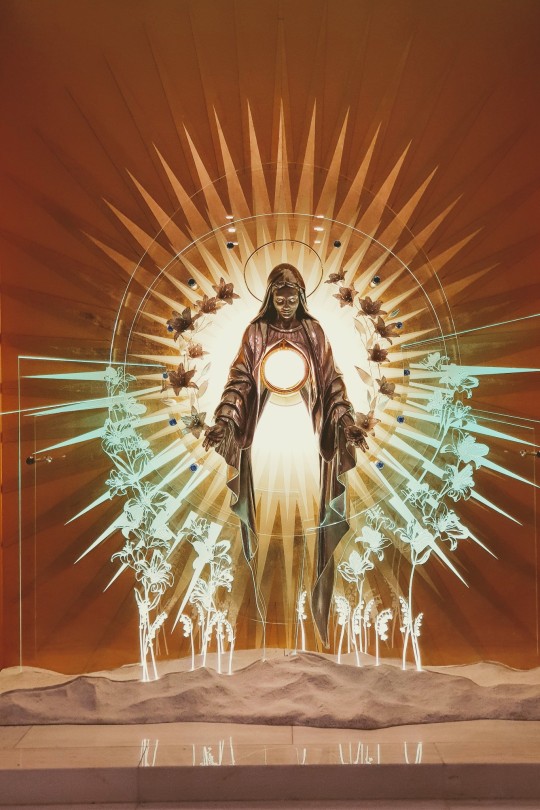


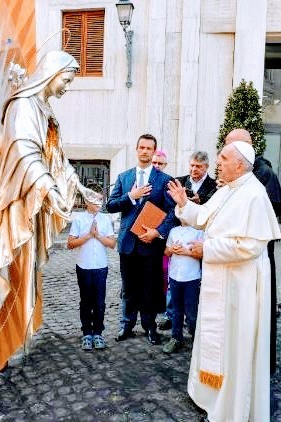
"In 1934 St. Maximilian Kolbe wrote in letter from Japan: 'I picture a beautiful statue of the Immaculate within a large altar, and in front of her, between spread arms - a monstrance in perpetual exposition of the Blessed Sacrament.'
In 2017 this was realised. The adoration chapel in Niepokalanow is one of 8 places in the world, where people pray for peace and reconciliation. That is why it is also known as the Peace Chapel.
A special indulgence is granted to those who visit, even virtually. You will receive under the normal conditions: being in the state of sanctifying grace, pious Holy Communion, remorse for sin and prayer (including adoration), ending with 'Our Father', 'Apostles’ Creed' and 'Holy Virgin Mary pray for us' and 'St. Maximilian Maria Kolbe pray for us.'"
-EWTN Polska | Adoracja z Niepokalanowa
#The Star of the Immaculate#World Center of Prayer for Peace#Eucharistic Adoration#st. maximilian kolbe#saint maximilian kolbe#catholic#franciscan#virgin mary#niepokalanow#poland#Gwiazda Niepokalanej#Światowe Centrum Modlitwy o Pokój#prayer#chapel#monstrance#st. maximilian kolbe pray for us#blessed virgin mary pray for us
293 notes
·
View notes
Video
youtube
The Servant Brothers of the Home of the Mother have produced this documentary about the life of Saint Maximilian Mary Kolbe, an outstanding Catholic figure of the 20th century.
Kolbe was a man with great apostolic zeal, a precursor in the use of the Mass Media for the transmission of the Gospel and consumed his life with the testimony of love as a martyr of charity in Auschwitz.
The source of his zeal was his passionate love for the Mother of God, the Immaculate. In the midst of many exterior difficulties, physically limited by his tuberculosis, he worked passionately for the spread of the Gospel. He was a missionary in Japan, and his publications reached as far as India, China, and even Arabia.
He founded a city in Poland called Niepokalanow dedicated to the Blessed Virgin. Saint Maximilian Mary is an example of generosity in the surrendering of oneself to God and encourages us to foment a tender devotion to Mary. To belong to the Immaculate was his ideal.
Greater love has no one than this, that one lay down his life for his friends.
18 notes
·
View notes
Text

Memorial of Saint Maximilian Kolbe, priest and martyr
Maximilian Kolbe was ordained in 1918 in Rome, and returned to Poland to teach history in the Crakow seminary. He founded a new monastery of Niepokalanow. By 1939 the monastery housed a religious community of nearly 800 men, the largest in the world in its day, and was completely self-sufficient including medical facilities. During World War II, Maximilian Kolbe and his brothers housed 3,000 Polish refugees, two-thirds Jewish. Their publications included materials considered anti-Nazi, and the congregation suppressed, and the brothers dispersed. Maximilian was imprisoned in Warsaw, Poland. On 28 May 1941 he was transferred to Auschwitz and branded as prisoner 16670. He was assigned to a group staffed by priests and supervised by especially abusive guards. His calm dedication to the faith brought him the worst jobs available, and more beatings than anyone else. In July 1941 there was an escape from the camp, and ten men were to be slaughtered in retribution for each escaped prisoner. Francis Gajowniczek, a married man with young children was one of the ten chosen to die. Maximilian volunteered to take his place, and died as he had always wished - in service of Jesus Christ. Maximilian Kolbe was canonized by Pope John Paul II on October 10, 1982. "Greater love has no man than this, that a man lay down his life for his friends" (John 15:13).
1 note
·
View note
Text
August 14 is the feast day of St. Maximilian Mary Kolbe, priest and martyr

Source of picture: https://franciscanmissionservice.org
Life of St. Maximilian Mary Kolbe
“I don’t know what’s going to become of you!” How many parents have said that? Maximilian Mary Kolbe’s reaction was, “I prayed very hard to Our Lady to tell me what would happen to me. She appeared, holding in her hands two crowns, one white, one red. She asked if I would like to have them—one was for purity, the other for martyrdom. I said, ‘I choose both.’ She smiled and disappeared.” After that he was not the same.
He entered the minor seminary of the Conventual Franciscans in Lvív–then Poland, now Ukraine– near his birthplace, and at 16 became a novice. Though Maximilian later achieved doctorates in philosophy and theology, he was deeply interested in science, even drawing plans for rocket ships.
Ordained at 24, Maximilian saw religious indifference as the deadliest poison of the day. His mission was to combat it. He had already founded the Militia of the Immaculata, whose aim was to fight evil with the witness of the good life, prayer, work, and suffering. He dreamed of and then founded Knight of the Immaculata, a religious magazine under Mary’s protection to preach the Good News to all nations.
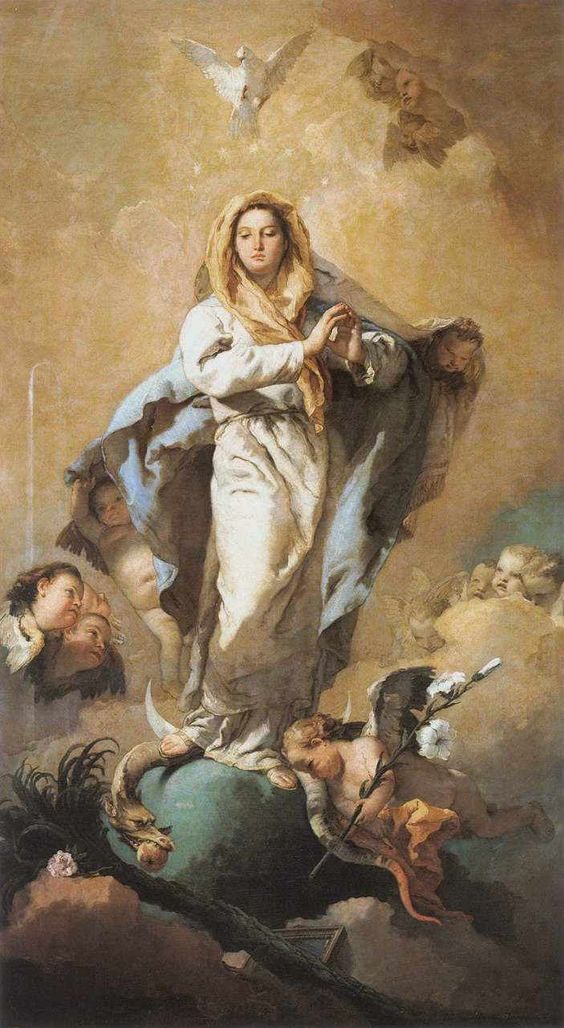
Source of picture: www.catholicgentleman.net
In 1939, the Nazi panzers overran Poland with deadly speed. Niepokalanow was severely bombed. Kolbe and his friars were arrested, then released in less than three months, on the feast of the Immaculate Conception.
In 1941, Fr. Kolbe was arrested again. The Nazis’ purpose was to liquidate the select ones, the leaders. The end came quickly, three months later in Auschwitz, after terrible beatings and humiliations.
A prisoner had escaped. The commandant announced that 10 men would die. He relished walking along the ranks. “This one. That one.”
As they were being marched away to the starvation bunkers, Number 16670 dared to step from the line.
“I would like to take that man’s place. He has a wife and children.”
“Who are you?”
“A priest.”
No name, no mention of fame. Silence. The commandant, dumbfounded, perhaps with a fleeting thought of history, kicked Sergeant Francis Gajowniczek out of line and ordered Fr. Kolbe to go with the nine. In the “block of death” they were ordered to strip naked, and their slow starvation began in darkness. But there was no screaming—the prisoners sang. By the eve of the Assumption, four were left alive. The jailer came to finish Kolbe off as he sat in a corner praying. He lifted his fleshless arm to receive the bite of the hypodermic needle. It was filled with carbolic acid. They burned his body with all the others.
Source: https://www.franciscanmedia.org/saint-maximilian-mary-kolbe/
"Love Alone Creates" Prayer
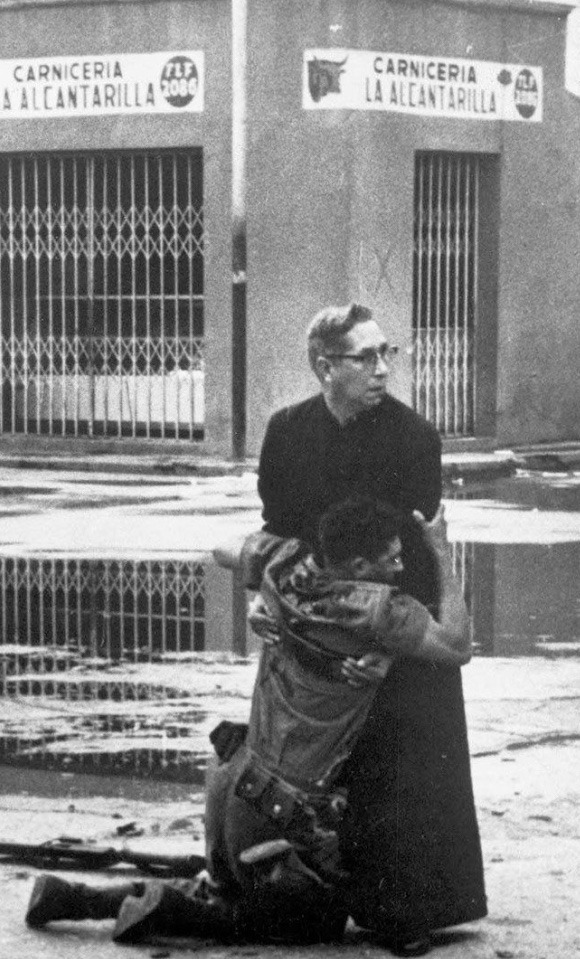
A wounded soldier in Venezuela clings to a priest (1963)
St. Maximilian, amidst the hate and lonely misery of Auschwitz, you brought love into the lives of fellow captives, and sowed the seeds of hope amidst despair. You bore witness to the world, by word and deed, that only "Love alone creates."
Help me to become more like yourself. With you and Mary and the Church, may I proclaim that only "Love alone creates." To the hungry and oppressed, the naked and homeless, the scorned and hated, the lonely and despairing, may I proclaim the power of Christ's love, which endures forever and ever. Amen.
Source: https://missionimmaculata.com
#saints#prayer#St. Maximilian Mary Kolbe#priest#martyr#God#Jesus#Christ#Jesus Christ#Father#Son#Holy Spirit#Holy Trinity#christian religion#Virgin Mary#Virgin Mother#Mary#Immaculata#faith#hope#love#Church#Love alone creates#amidst the hate and lonely misery of Auschwitz you brought love#let us remember that love lives through sacrifice and is nourished by giving#sacrifice#giving#Christ's love#Love Alone Creates Prayer
3 notes
·
View notes
Photo
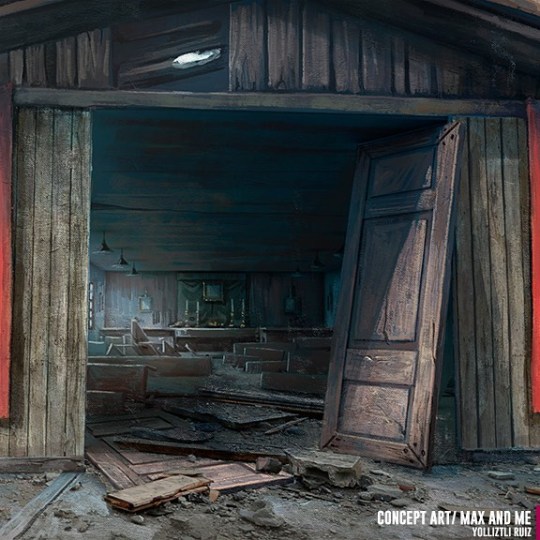
#conceptart #naziinvasion #wwii #niepokalanow #photobashing #historicmoment #paintover #digitalart #film #showmywork (en Niepokalanów)
#naziinvasion#niepokalanow#photobashing#film#paintover#digitalart#wwii#conceptart#historicmoment#showmywork
0 notes
Text
14th August >> Saint of the Day for Roman Catholics: Saint Maximilian M Kolbe, Priest and Martyr (Memorial)
St Maximilian M. Kolbe, Priest and Martyr (Memorial)
Maximilian Kolbe was born Rajmund on 8 January 1894 in Zduńska Wola, which was at that time part of the Russian Empire. Rajmund was the second son of Julius Kolbe and Maria Dabrowska. His father was an ethnic German and his mother of Polish origin. He had four brothers, two of whom died very young. His parents moved to Pabianice where they worked first as weavers. Later his mother worked as a midwife (often without charge) and ran a grocery and household goods shop in part of her rented house. Julius Kolbe worked at weaving mills and also grew vegetables on a rented allotment. In 1914 he joined Józef Piłsudski’s Polish Legions fighting for Poland’s independence from Russia and was captured. Regarded as a Russian subject, he was hanged as a traitor in 1914, aged forty-three.
In 1907 Rajmund and his elder brother Francis decided to join the Conventual Franciscans. They illegally crossed the border between Russia and Austria-Hungary and joined a Conventual Franciscan junior seminary in Lwów. In 1910 Kolbe entered the novitiate. He professed his first vows in 1911.
In 1912 he was sent to Kraków and then on to Rome where he took final vows in 1914, adopting the names Maximilian Maria, to show his veneration of the Blessed Virgin Mary. In Rome he studied philosophy, theology, mathematics, and physics. He took a great interest in astrophysics and the prospect of space flight and the military. While in Rome he designed an airplane-like spacecraft, similar in concept to the eventual space shuttle, and tried to patent it. In 1918 he was ordained a priest. He earned a doctorate in philosophy in 1915 at the Pontifical Gregorian University and a doctorate in theology in 1919 at the Pontifical University of St. Bonaventure. During his time as a student, he witnessed demonstrations by Freemasons against Popes Pius X and Benedict XV. This inspired him to organize the Militia Immaculatae (Army of Mary) to work for the conversion of sinners and enemies of the Catholic Church, through the intercession of the Virgin Mary.
In 1919 he was diagnosed as having tuberculosis and returned to a newly independent Poland.
Here his main work was teaching Church history in a seminary. Another attack of tuberculosis was followed by the re-siting of his printing presses at Niepokalanow, near Warsaw. Here Maximilian founded a Franciscan community which combined prayer, cheerfulness and simplicity of life with modern technology, as well as a seminary, a radio station and several other organisations and publications. He was also very active in promoting the veneration of the Immaculate Virgin Mary. His movement had its own magazine, Militia Immaculatae, in which he particularly condemned Freemasonry, Communism, Zionism, Capitalism and Imperialism. Not long after, the presses were moved to Grodno, circulation increased to 45,000 and new machinery was installed.
Between 1930 and 1936 he went on a series of missions to Japan, where he founded a friary on the outskirts of Nagasaki, a Japanese newspaper and a seminary. Because, against local advice, the friary was not built on the ‘propitious’ side of the mountain it was spared the devastation caused by the atomic bomb in 1945. After founding another community at Nagasaki in Japan, Maximilian was recalled in 1936 as superior of Niepokalanow, which grew to number 762 friars.
When the Germans invaded Poland in 1939, Kolbe, realising that his monastery would be taken over, sent most of the friars home, warning them not to join the underground resistance.
During the Second World War the friary provided shelter to refugees from Greater Poland, including 3,000 Poles and 1,500 Jews. Maximilian was also active as a radio amateur, attacking Nazi activities through his reports. For some time his newspapers continued publication, taking a patriotic, independent line, critical of the Third Reich. Kolbe, who had refused German citizenship, was finally arrested on 17 February 1941 as a journalist, publisher and ‘intellectual’. Gestapo officers were shown round the whole friary and were astonished at the small amount of food prepared for the friars. He was imprisoned in the Pawiak prison and on 25 May was transferred to Auschwitz I as prisoner #16670. In the camp the heavy work of moving loads of heavy logs at double speed was enforced by kicks and lashes. Maximilian also had to remove the bodies of those who died of torture. At the same time, he continued his priestly ministry, hearing confessions in unlikely places and smuggling in bread and wine to celebrate the Eucharist. He was noted for his sympathy and compassion towards those even more unfortunate than himself.
In July 1941 a prisoner from Kolbe’s barracks vanished, prompting the deputy camp commander to pick 10 men from the same barracks to be starved to death in the notorious Block 13 as punishment for his escape. (In fact, he was found later to have drowned – deliberately? – in the camp latrine.)
When one of those selected, Franciszek Gajowniczek, cried out in distress at having been chosen, Maximilian volunteered to take his place. He stepped forward, saying: “I am a Catholic priest. I wish to die for that man. I am old; he has a wife and children.” During the days in the death chamber of Cell 18, he led his companions in songs and prayer. After three weeks of dehydration and starvation, only Kolbe and three others were still alive. He was finally put to death on 14 August 1941 with an injection of carbolic acid.
He was beatified by Pope Paul VI in 1971 and canonized on 10 October 1982 by Pope John Paul II, a former archbishop of Kracov, the diocese where Auschwitz was located. Among those present was Franciszek Gajowniczek, the man whose place Kolbe had taken.
Maximilian Kolbe is the patron saint of drug addicts, political prisoners, families, journalists, prisoners and the pro-life movement. Pope John Paul II also declared him the “Patron Saint of Our Difficult Century”
Kolbe is one of ten 20th-century martyrs depicted in statues above the Great West Door of Westminster Abbey, London.
Franciszek Gajowniczek
He died on March 13, 1995, at Brzeg in Poland, 95 years old – and 53 years after Kolbe had saved him. But he was never to forget the ragged monk. After his release from Auschwitz, Gajowniczek spent the next five decades paying homage to Father Kolbe, honoring the man who died on his behalf.
In December 1994, the 94-year-old Pole visited St. Maximilian Kolbe Catholic Church of Houston. His translator on that trip, Chaplain Thaddeus Horbowy, said: "He told me that as long as he . . . has breath in his lungs, he would consider it his duty to tell people about the heroic act of love by Maximilian Kolbe."
25 notes
·
View notes
Photo
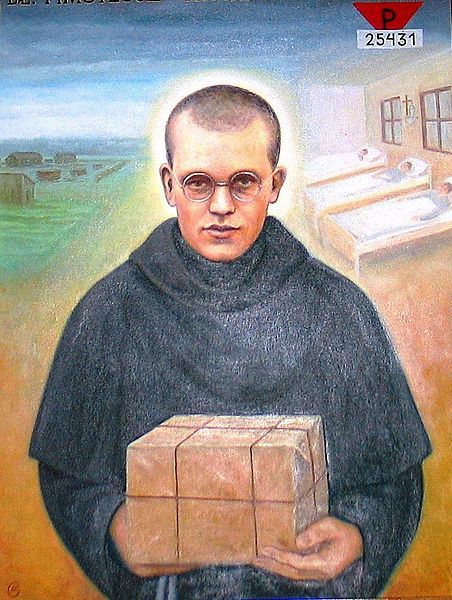
Saint of the Day – 28 February – Blessed Stanislaw Antoni Trojanowski (1908-1942) Martyr and Religious Brother – also known as: Tymoteusz, Timoteo Trojanowski, Stanislaw Tymoteusz Trojanowski, prisoner 25431. Born on 29 July 1908 in Sadlowo, Mazowieckie, diocese of Plock, Poland – 28 February 1942 in the death camp hospital at Oswiecim (Auschwitz), Malopolskie, Nazi-occupied Poland of pneumonia. He was Beatified on 13 June 1999 by St Pope John Paul II.
In the Auschwitz death camp near Krakow in Poland, Blessed Timoteusz Trojanowski, a Brother of the Order of Friars Minor Conventual and martyr, who, during the domination of his homeland under a regime hostile to humanity and religion, exhausted by tortures suffered for confessing his Christian faith, brought to fruition his martyrdom.
Stanislaw Antoni was born 29 July 1908 in the village of Sadlowo, in the diocese of Plock, parents and Ignacy Franciszka Zebkiewicz. The precarious economic situation of the family led him to work from an early age. This involved poor attendance at primary school. On 5 March 1930 he entered the convent of Friars Minor Conventual and Niepokalanow (founded by St Maximillian Kolbe) and on 6 January 1931 he was able to begin his novitiate with the name of Tymoteusz. He made a simple profession of vows on 2 February 1932 and professed his solemn vows on 11 February 1935. His whole religious life was held in Niepokalanow, working in the shipping department of the magazine “Knights of the Immaculate Conception” in the warehouse and infirmary, where he devoted himself to the sick brethren.
On 3 May 1937, he reported to his superior his wish to go on a mission “anywhere, anytime, provided the will of God.”
He was disciplined and faithful to his vocation, had great confidence on the part of his famous superior, Father Kolbe.
With the outbreak of World War II in 1939, he chose to remain at Niepokalanow. On 14 October 1941 he was arrested by the Gestapo with six brothers, including a Friar Bonifacy and locked up in prison in Warsaw because they were Catholics. In prison he was able to devote much time to prayer, bolstering the courage to others.
On 8 January 1942 he was again deported with Bonifacy to the concentration camp of Oswiecim with the number 25431. He was originally intended for the transport of construction materials, then the excavation and transport of gravel and finally to the collection of rapeseed. He endured, with great courage, the hunger, cold and hard work. He never lost heart, always encouraging others to trust in the protection of God. The cold caused the pneumonia that led to his death in the hospital at the death camp on 28 February 1942. (From the translated Roman Martyrology)
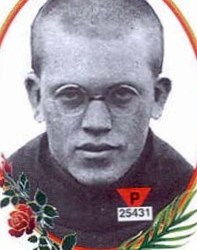
(via AnaStpaul – Breathing Catholic)
#blstanislawantonitrajanowski#february28blstanislawtrajanowski#martyrofauschwitz#catholic#catholicism
19 notes
·
View notes
Photo
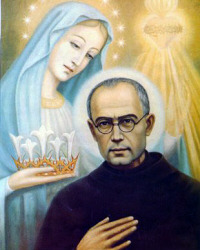
Saint Maximilian Kolbe - Feast Day: August 14th - (Ordinary Time) - Mary’s Knight
His name wasn't always Maximilian. He was born the second son of a poor weaver on 8 January 1894 at Zdunska Wola near Lodz in Poland, and was given the baptismal name of Raymond. Both parents were devout Christians with a particular devotion to Mary. In his infancy, Raymond seems to have been normally mischievous but we are told that one day, after his mother had scolded him for some mischief or other, her words took effect and brought about a radical change in the child's behaviour. Later he explained this change. "That night, I asked the Mother of God what was to become of me. Then she came to me holding two crowns, one white, the other red. She asked me if I was willing to accept either of these crowns. The white one meant that I should persevere in purity, and the red that I should become a martyr. I said that I would accept them both." Thus early did the child believe and accept that he was destined for martyrdom. His belief in his dream coloured all his future actions.
In 1907, Raymond and his elder brother entered a junior Franciscan seminary in Lwow in Polish (Also known as Lviv in Ukrainian - which is the largest city in western Ukraine and the seventh-largest city in the country overall, with a population of around 728,350 as of 2016. Lviv is one of the main cultural centres of Ukraine). Here he excelled in mathematics and physics and his teachers predicted a brilliant future for him in science. Others, seeing his passionate interest in all things military, saw in him a future strategist. For a time indeed, his interest in military affairs together with his fiery patriotism made him lose interest in the idea of becoming a priest. The fulfillment of his dream would lie in saving Poland from her oppressors as a soldier. But before he could tell anyone about his decision his mother announced that, as all their children were now in seminaries, she and her husband intended to enter religious life. Raymond hadn't the heart to upset his parents' plans and so he abandoned his plans for joining the army. He was recieved as a novice in September 1910 and with the habit he took the new name of Maximilian. From 1912 to 1915, he was in Rome studying philosophy at the Gregorian College, and from 1915 to 1919 theology at the Collegio Serafico. He was ordained in Rome on 28 April 1918.
The love of fighting didn't leave him, but while he was in Rome he stopped seeing the struggle as a military one. He didn't like what he saw of the world, in fact he saw it as downright evil. The fight, he decided, was a spiritual one. The world was bigger than Poland and there were worse slaveries than earthly ones. The fight was still on, but he would not be waging it with the sword. At that time, many Catholics in Europe regarded freemasonry as their chief enemy; and it was against the freemasons that Maximilian Kolbe began to wage war. On 16 October 1917, with six companions, he founded the Crusade of Mary Immaculate (Militia Immaculatae), with the aim of "converting sinners, heretics and schismatics, particularly freemasons, and bringing all men to love Mary Immaculate".
As he entered what was to be the most creative period of his life, Fr Maximilian's health had already begun to deteriorate. He was by now in an advanced state of tuberculosis, and he felt himself overshadowed by death. His love for Mary Immaculate now became the devouring characteristic of his life. He regarded himself as no more than an instrument of her will, and the only time he was known to lose his temper was in defence of her honour. It was for her that he strove to develop all the good that was in him, and he wanted to encourage others to do the same.
When Maximilian returned to Poland in 1919, he rejoiced to see his country free once again, a liberation which he attributed to Mary Immaculate. Pius XI, in response to a request from the Polish bishops, had just promulgated the Feast of Our Lady, Queen of Poland, and Fr Maximilian wrote: "She must be the Queen of Poland of every Polish heart. We must labour to win each and every heart for her." He set himself to extend the influence of his Crusade, and formed cells and circles all over Poland. The doctors had by now pronounced him incurable; one lung had collapsed and the other was damaged. Yet it was now that he flung himself into a whirlwind of activity. In January 1922, he began to publish a monthly review, the Knight of the Immaculate, in Krakow. Its aim was to "illuminate the truth and show the true way to happiness". As funds were low, only 5,000 copies of the first issue were printed. In 1922, he removed to another friary in Grodno and acquired a small printing establishment; and from now on the review began to grow. In 1927, 70,000 copies were being printed. The Grodno Friary became too small to house such a mammoth operation, so Fr Maximilian began to look for a site nearer to Warsaw. Prince Jan Drucko-Lubecki offered him some land at Teresin, west of Warsaw, Fr Maximilian promptly erected a statue of Mary Immaculate there, and the monks began the arduous work of construction.
On 21 November 1927, the Franciscans moved from Grodno to Teresin and on 8 December, the friary was consecrated and was given the name of Niepokalanow, the City of the Immaculate. "Niepokalanow", said Fr Maximilian, "is a place chosen by Mary Immaculate and is exclusively dedicated to spreading her cult. All that is and will be at Niepokalanow will belong to her. The monastic spirit will flourish here; we shall practise obedience and we shall be poor, in the spirit of St Francis."
At first, Niepokalanow consisted of no more than a few shacks with tar-paper roofs, but it soon flourished. To cope with the flood of vocations all over Poland, a junior seminary was built at Niepokalanow "to prepare priests for the missions capable of every task in the name of the Immaculate and with her help". A few years later, there were more than a hundred seminarians and the numbers were still growing. Before long, Niepokalanow had become one of the largest (some say the largest) friaries in the world. In 1939, it housed 762 inhabitants: 13 priests, 18 novices, 527 brothers, 122 boys in the junior seminary and 82 candidates for the priesthood. No matter how many labourers were in the vineyard, there was always work for more. Among the inhabitants of Niepokalanow there were doctors, dentists, farmers, mechanics, tailors, builders, printers, gardeners, shoemakers, cooks. The place was entirely self supporting.
Not only the friary but the printing house had been expanding. More modern machinery had been installed, including three machines which could produce 16,000 copies of the review in an hour. New techniques of type, photogravure (an image produced from a photograph negative) and binding were adopted. The new machinery and techniques made it possible to meet the growing demand for Knight of the Immaculate -- which had now reached the incredible circulation figure of 750,000 per month -- and to produce other publications as well. In 1935, they began to produce a daily Catholic newspaper, The Little Daily, of which 137,000 copies were printed on weekdays and 225,000 on Sundays and holydays.
Maximilian did not rest content with mere journalistic activity. His sights were set even further. On 8 December 1938, a radio station was installed at Neipokalanow with the signature tune (played by the brothers' own orchestra) of the Lourdes hymn. And now that there was so much valuable equipment around, Niepokalanow acquired its own fire brigade to protect it against its enemies. Some of the brothers were now trained as firemen.
There was no doubt that Niepokalanow was going from strength to strength, a unique situation within Poland. The results of the work done there were becoming apparent. Priests in parishes all over the country reported a tremendous upsurge of faith, which they attributed to the literature emerging from Niepokalanow. A campaign against abortion in the columns of the Knight (1938) seemed to awaken the conscience of the nation: more than a million people of all classes and professions ranged themselves behind the standard of Mary Immaculate. Years later, after the war, the Polish bishops sent an official letter to the Holy See claiming that Fr Kolbe's magazine had prepared the Polish nation to endure and survive the horrors of the war that was soon to follow.
Fr Maximilian was a restless spirit, and his activities could not be confined to Poland. His junior seminary had been started in 1929, but he didn't intend to wait for its first priest to be trained before he himself set out for the mission lands. To those who pointed out that Niepokalonow wasn't yet up to undertaking foreign apostolic work, he quoted the example of St Francis, who had risked himself on the mission fields when the other Orders had remained uninvolved. With the blessing of his Father General, Maximilian prepared his expedition. Asked whether he had money to finance it, he replied: "Money? It will turn up somehow or other. Mary will see to it. It's her business and her Son's."
On 26 February 1930, Fr Maximilian left Poland with four brothers from Niepokalanow on a journey to the Far East. They travelled by way of Port Said, Saigon and Shanghai, and on 24 April they landed at Nagasaki in Japan. Here they were given epispcopal permission to stay. In fact Archbishop Hayasaka received them very warmly when he learned that Fr Maximilian had two doctorates and would be able to take the vacant chair of philosophy in the diocesan seminary in exchange for a license to print his review.
The going was hard. The Poles' only shelter was a wretched hut whose walls and roof were caving in. They slept on what straw they could find and their tables were planks of wood. But despite such hardships, and the fact that they knew no word of the Japanese language, and had no money, on 24 April 1930, exactly a month after their arrival, a telegram was despatched to Niepokalanow: "Today distributing Japanese Knight. Have printing press. Praise to Mary Immaculate." After that, it was scarcely surprising that a year later the Japanese Niepokalanow was inaugurated -- Mugenzai no Sono (the Garden of the Immaculate), built on the slopes of Mount Kikosan. The choice of this site in the suburbs had been dictated by poverty, but it proved to be a lucky one. People thought Fr Maximilian was crazy to be building on steep ground sloping away from the town; but in 1945, when the atomic bomb all but leveled Nagaskai, Mugenzai no Sono sustained no more damage than a few broken pains of stained glass. Today it forms the centre of a Franciscan province.
Despite his passionate zeal in the cause of Mary, Fr Maximilian proved to be a wise missionary. He did not attempt to impose Western ideas on the Japanese. He respected their national customers and looked for what was good in Buddhism and Shintoism. He entered into dialogue with Buddhist priests and some of them became his friends. In 1931, he founded a novitiate, and in 1936 a junior seminary. And of course he continued to publish his beloved magazine. Seibo no Kishi, the Japanese Knight, had a circulation six times that of the nearest Japanese Catholic rival. This was because it was aimed at the whole community, not just Catholics. The first 10,000 copies had swollen to 65,000 by 1936.
Fr. Maximilian's health was rapidly deteriorating, but he didn't allow this fact to diminish his zeal -- or his restless energy. Although he often complained of the lack of manpower and machines needed to serve the people of Japan, in 1932 he was already seeking fresh pastures. On 31 May he left Japan and sailed to Malabar where, after a few initial difficulties, he founded the third Niepokalanow. But his superiors requested him to return to Japan, and as no priests could be spared for Malabar, that idea had to be given up. On another of his journeys, he travelled through Siberia and spent some time in Moscow. Even here, he dreamed of publishing his magazine -- in Russian. He had studied the language and had a fair acquaintance with marxist literature. Like Pope John XXIII, he looked for the good elements, even in systems he believed to be evil; and he tried to teach his friars to do likewise.
In 1936, he was recalled to Poland, and left Japan for the last time. He had thought that he would find martyrdom there; and indeed he had found martyrdom of a kind. He was racked by violent headaches and covered with abscesses brought on by the food to which he could not grow accustomed. But these things were only pinpricks: the real martyrdom awaited him elsewhere.
Just before the Second World War broke out, Fr Maximilian spoke to his friars about suffering. They must not be afraid, he said, for suffering accepted with love would bring them closer to Mary. All his life, he had dreamt of a martyr's crown, and the time was nearly at hand.
By 13 September 1939, Niepokalanow had been occupied by the invading Germans and most of its inhabitants had been deported to Germany. Among them was Fr Maximilian. But that exile did not last long and on 8 December (the feast of the Immaculate Conception) the prisoners were set free. From the moment that he returned to Niepokalanow, Fr Maximilian was galvanised into a new kind of activity. He began to organize a shelter for 3,000 Polish refugees, among whom were 2,000 Jews. "We must do everything in our power to help these unfortunate people who have been driven from their homes and deprived of even the most basic necessities. Our mission is among them in the days that lie ahead." The friars shared everything they had with the refugees. They housed, fed and clothed them, and brought all their machinery into use in their service.
Inevitably, the community came under suspicion and was watched closely. Early in 1941, in the only edition of The Knight of the Immaculate which he was allowed to publish, Fr Maximilian set pen to paper and thus provoked his own arrest. "No one in the world can change Truth," he wrote. "What we can do and should do is to seek truth and to serve it when we have found it. The real conflict is the inner conflict. Beyond armies of occupation and the catacombs of extermination camps, there are two irreconcilable enemies in the depth of every soul: good and evil, sin and love. And what use are the victories on the battlefield if we ourselves are defeated in our innermost personal selves?"
He would never know that kind of defeat; but a more obvious defeat was near. On 17 February 1941, he was arrested and sent to the infamous Pawiak prison in Warsaw. Here he was singled out for special ill-treatment. A witness tells us that in March of that year an SS guard, seeing this man in his habit girdled with a rosary, asked if he believed in Christ. When the priest calmly replied, "I do", the guard struck him. The SS man repeated his question several times and receiving always the same answer went on beating him mercilessly. Shortly afterwards the Franciscan habit was taken away and a prisoner's garment was substituted. On 28 May, Fr Maximilian was with over 300 others who were deported from Pawiak to Auschwitz. There he received his striped convict's garments and was branded with the number 16670. He was put to work immediately carrying blocks of stone for the construction of a crematorium wall. On the last day of May he was assigned with other priests to the Babice section which was under the direction of "Bloody" Krott, an ex-criminal. "These men are layabouts and parisites", said the Commandant to Krott, "get them working." Krott forced the priests to cut and carry huge tree trunks. The work went on all day without a stop and had to be done running --- with the aid of vicious blows from the guards. Depsite his one lung, Father Maximilain accepted the work and the blows with surprising calm. Krott conceived a relentless hatred against the Franciscan and gave him heavier tasks than the others. Sometimes his colleagues would try to come to his aid but he would not expose them to danger. Always he replied, "Mary gives me strength. All will be well." At this time he wrote to his mother, "Do not worry about me or my health, for the good Lord is everywhere and holds every one of us in his great love."
One day, Krott found some of the heaviest planks he could lay hold of and personally loaded them on the Franciscan's back, ordering him to run. When he collapsed, Krott kicked him in the stomach and face and had his men give him fifty lashes. When the priest lost consciousness Krott threw him in the mud and left him for dead. But his companions managed to smuggle him to the Revier, the camp hospital. Although he was suffering greatly, he secretly heard confessions in the hospital and spoke to the other inmates of the love of God. In Aushcwitz, where hunger and hatred reigned and faith evaporated, this man opened his heart to others and spoke of God's infinite love. He seemed never to think of himself. When food was brought in and everyone struggled to get his place in the queue so as to be sure of a share, Fr Maximilian stood aside, so that frequently there was none left for him. At other times he shared his meager ration of soup or bread with others. He was once asked whether such self abnegation made sense in a place where every man was engaged in a struggle or survival, and he answered: "Every man has an aim in life. For most men it is to return home to their wives and families, or to their mothers. For my part, I give my life for the good of all men.
Men gathered in secret to hear his words of love and encouragement, but it was his example which counted for most. Fr Zygmunt Rusczak remembers: "Each time I saw Fr. Kolbe in the courtyard I felt within myself an extraordinary effusion of his goodness. Although he wore the same ragged clothes as the rest of us, with the same tin can hanging from his belt, one forgot his wretched exterior and was conscious only of the charm of his inspired countenance and of his radiant holiness."
There remained only the last act in the drama. The events are recorded in the sworn testimonials of former inmates of the camp, collected as part of the beatification proceedings.
They are as follows:
Tadeusz Joachimowski, clerk of Block 14A: "In the summer of 1941, most probably on the last day of July, the camp siren announced that there had been an escape. At the evening roll-call of the same day we, ie Block 14A, were formed up in the street between the buildings of Blocks 14 and 17. After some delay we were joined by a group of the Landwirtschafts-Kommando. During the count it was found that three prisoners from this Kommando had escaped: one from our Block and the two others from other Blocks. Lagerfuhrer Fritzsch announced that on account of the escape of the three prisoners, ten prisoners would be picked in reprisal from the blocks in which the fugitives had lived and would be assigned to the Bunker (the underground starvation cell)"
Jan Jakub Zegidewicz takes up the story from there: "After the group of doomed men had already been selected, a prisoner stepped out from the ranks of one of the Blocks. I recognized Fr Kolbe. Owing to my poor knowledge of German I did not understand what they talked about, nor do I remember whether Fr Kolbe spoke directly to Fritzsch. When making his request, Fr Kolbe stood at attention and pointed at a former non-commissioned officer known to me from the camp. It could be inferred from the expression on Fritzsch's face that he was surprised at Fr Kolbe's action. As the sign was given, Fr Kolbe joined the ranks of the doomed and the non-commissioned officer left the ranks of the doomed Firzsch had consented to the exchange. A little later, the doomed men were marched off in the direction of Block 13, the death Block.
The non-commissioned officer was Franciszek Gajowniczek. When the sentence of doom had been pronounced, Gajowniczek had cried out in despair, "Oh, my poor wife, my poor children. I shall never see them again." It was then that the unexpected had happened, and that from among the ranks of those temporarily reprieved, prisoner 16670 had stepped forward and offered himself in the other man's place. Then the ten condemned men were led off to the dreaded Bunker, to the airless underground cells where men died slowly without food or water.
Bruno Borgowiec was an eyewitness of those last terrible days, for he was an assistant to the janitor and an interpreter in the underground Bunkers. He tells us what happened: "In the cell of the poor wretches there were daily loud prayers, the rosary and singing, in which prisnoers from neighbouring cells also joined. When no SS men were in the Block, I went to the Bunker to talk to the men and comfort them. Fervent prayers and songs to the Holy Mother resounded in all the corridors of the Bunker. I had the impression I was in a church. Fr Kolbe was leading and the prisoners responded in unison. They were often so deep in prayer that they did not even hear that inspecting SS men had descended to the Bunker; and the voices fell silent only at the loud yelling of their visitors. When the cells were opened the poor wretches cried loudly and begged for a piece of bread and for water, which they did not receive, however. If any of the stronger ones approached the door he was immediately kicked in the stomach by the SS men, so that falling backwards on the cement floor he was instantly killed; or he was shot to death ... Fr Kolbe bore up bravely, he did not beg and did not complain but raised the spirits of the others. ...Since they had grown very weak, prayers were now only whispered. At every inspection, when almost all the others were now lying on the floor, Fr Kolbe was seen kneeling or standing in the centre as he looked cheerfully in the face of the SS men. Two weeks passed in this way. Meanwhile one after another they died, until only Fr Kolbe was left. This the authorities felt was too long; the cell was needed for new victims. So one day they brought in the head of the sickquarters, a German, a common criminal named Bock, who gave Fr Kolbe an injection of carbolic acid in the vein of his left arm. Fr Kolbe, with a prayer on his lips, himself gave his arm to the executioner. Unable to watch this I left under the pretext of work to be done. Immediately after the SS men with the executioner had left I returned to the cell, where I found Fr Kolbe leaning in a sitting position against the back wall with his eyes open and his head dropping sideways. His face was calm and radiant."
The heroism of Fr Kolbe went echoing through Auschwiz. In that desert of hatred he had sown love. Mr Jozef Stemler, former director of an important cultural institute in Poland, comments: "In those conditions ... in the midst of a brutalization of thought and feeling and words such as had never before been known, man indeed became a ravening wolf in his relations with other men. And into this state of affairs came the heroic self-sacrifice of Fr Maximilian. The atmosphere grew lighter, as this thunderbolt provoked its profound and salutary shock." Jerzy Bielecki declared that Fr Kolbe's death was "a shock filled with hope, bringing new life and strength. ...It was like a powerful shaft of light in the darkness of the camp."
His reputation spread far and wide, through the Nazi camps and beyond. After the war newspapers all over the world were deluged with articles about this "saint for our times", "saint of progress", "giant of holiness". Biographies were written, and everywhere there were claims of cures being brought about through his intercession. "The life and death of this one man alone," wrote the Polish bishops, "can be proof and witness of the fact that the love of God can overcome the greatest hatred, the greatest injustice, evern death itself." The demands for his beatification became insistent, and at last on 12 August 1947 proceedings started. Seventy-five witnesses were questioned. His cause was introduced on 16 March 1960. When all the usual objections had been overcome, the promoter spoke of the "charm of this magnificent fool." On 17 October 1971, Maximilian Kolbe was beatified. Like his master Jesus Christ he had loved his fellow-men to the point of sacrificing his life for them. "Greater love hath no man than this ..." and these were the opening words of the papal decree introducing the process of beatification. Fr Kolbe's canonisation was not long delayed. It was the Pope from Poland, John Paul II, who had the joy of declaring his compatriot a saint on 10 October 1982.
St Maximilian Kolbe's feast day is 14 August, the day before the Feast of the Assumption of Our Lady.
Saint Maximilian Mary Kolbe, pray for us.
“For Jesus I am willing to suffer more “!
8 notes
·
View notes
Text
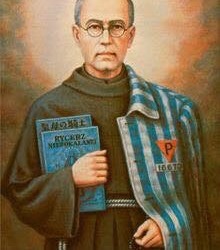
Memorial of Maximilian Kolbe, priest and martyr
Maximilian Kolbe was ordained in 1918 in Rome. He returned to Poland to teach history in the Crakow seminary. He founded a new monastery of Niepokalanow. By 1939 the monastery housed a religious community of nearly 800 men, the largest in the world in its day, and was completely self-sufficient including medical facilities. During World War II, Maximilian Kolbe and his brothers housed 3,000 Polish refugees, two-thirds of whom were Jewish. Their publications included materials considered anti-Nazi, and was shut down, the congregation suppressed, and the brothers dispersed. Maximilian was imprisoned in Warsaw, Poland, and on 28 May 1941 he was transferred to Auschwitz and branded as prisoner 16670. He was assigned to a special work group staffed by priests and supervised by especially abusive guards. His calm dedication to the faith brought him the worst jobs available, and more beatings than anyone else. In July 1941 there was an escape from the camp, and ten men were to be slaughtered in retribution for each escaped prisoner. Francis Gajowniczek, a married man with young children was one of the ten chosen to die. Maximilian volunteered to take his place, and died as he had always wished - in service of Jesus Christ.
1 note
·
View note
Text
24th November >> My Daily Eucharist - Reflection for Roman Catholics.
Only during the war could Father Kolbe realize his lifelong dream: daily adoration of the most Blessed Sacrament. Brother Benedict Mieczkowski recounts:
Immediately after his return from prison [1939], Father Maximilian introduced adoration of the most Blessed Sacrament throughout the entire day. He regarded this as the most efficacious means for meeting the needs of Niepokalanow and of his country. He announced this in the refectory and ordered me to assign groups of friars from each work sector to take turns adoring for a half-hour each. On each turn, there were several friars. In this way, each, including Father Maximilian, had his own time of adoration each day. Great care and attention were given to this activity. Often, in the early days, he himself would check and remind the brothers of this commitment, so that they would come to realize it as a duty and consider it of vital importance. But above all, he encouraged us with his example, more than once going to the chapel to take the place of someone absent. When he did not feel well, he would get his cane and, leaning on it, would take his place in the chapel for the period of adoration assigned him immediately after the afternoon rest, sometime between 3 and 4 p.m.
For The Life Of The World: Saint Maximilian And The Eucharist
Jerzy Domanski, O.F.M. Conv.
3 notes
·
View notes
Text
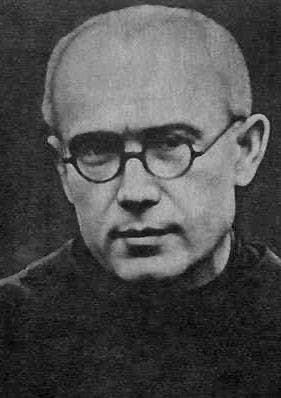
Memorial of Saint Maximilian Kolbe, priest and martyr
Maximilian Kolbe was ordained in 1918 in Rome, and returned to Poland to teach history in the Crakow seminary. He founded a new monastery of Niepokalanow. By 1939 the monastery housed a religious community of nearly 800 men, the largest in the world in its day, and was completely self-sufficient including medical facilities. During World War II, Maximilian Kolbe and his brothers housed 3,000 Polish refugees, two-thirds Jewish. Their publications included materials considered anti-Nazi, and the congregation suppressed, and the brothers dispersed. Maximilian was imprisoned in Warsaw, Poland. On 28 May 1941 he was transferred to Auschwitz and branded as prisoner 16670. He was assigned to a group staffed by priests and supervised by especially abusive guards. His calm dedication to the faith brought him the worst jobs available, and more beatings than anyone else. In July 1941 there was an escape from the camp, and ten men were to be slaughtered in retribution for each escaped prisoner. Francis Gajowniczek, a married man with young children was one of the ten chosen to die. Maximilian volunteered to take his place, and died as he had always wished - in service of Jesus Christ. Maximilian Kolbe was canonized by Pope John Paul II on October 10, 1982. "Greater love has no man than this, that a man lay down his life for his friends" (John 15:13).
0 notes
Photo
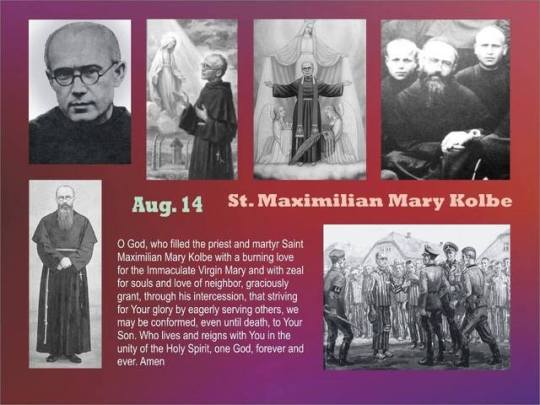
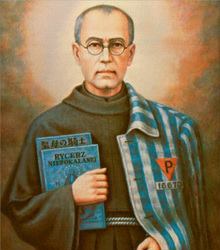
14th August Memorial of Maximilian Kolbe, priest and martyr
Maximilian Kolbe was ordained in 1918 in Rome. He returned to Poland to teach history in the Crakow seminary. He founded a new monastery of Niepokalanow. By 1939 the monastery housed a religious community of nearly 800 men, the largest in the world in its day, and was completely self-sufficient including medical facilities. During World War II, Maximilian Kolbe and his brothers housed 3,000 Polish refugees, two-thirds of whom were Jewish. Their publications included materials considered anti-Nazi, and was shut down, the congregation suppressed, and the brothers dispersed. Maximilian was imprisoned in Warsaw, Poland, and on 28 May 1941 he was transferred to Auschwitz and branded as prisoner 16670. He was assigned to a special work group staffed by priests and supervised by especially abusive guards. His calm dedication to the faith brought him the worst jobs available, and more beatings than anyone else. In July 1941 there was an escape from the camp, and ten men were to be slaughtered in retribution for each escaped prisoner. Francis Gajowniczek, a married man with young children was one of the ten chosen to die. Maximilian volunteered to take his place, and died as he had always wished - in service of Jesus Christ.
5 notes
·
View notes
Text
3rd May >> Daily Eucharist - Reflection for Roman Catholic on the Feast of Saints Philip and James, Apostles.
It made him happy to see a group of his friars around the altar in adoration. When he showed guests about Niepokalanow, at times Germans from the highest ranks of society, he either began or ended the visit in the chapel to greet, as he explained, the Master of the house. Indicating the religious adoring the most Blessed Sacrament, he would say: "There is the most important work department in the friary." This adoration was carried out simply before the tabernacle, except on first Fridays of the month when the Blessed Sacrament was exposed in a monstrance, and only during the day, not at night. Notwithstanding the ardent desire of the saint to have perpetual adoration, he took account of the exhaustion of the friars after a hard day's work. At times, however, he would give an individual permission for nocturnal adoration. For the Life of the World: St. Maximilian and the Eucharist Jerzy Domanski, O.F.M. Conv
1 note
·
View note
Text
24th November >> My Daily Eucharist - Reflection for Roman Catholics.
Only during the war could Father Kolbe realize his lifelong dream: daily adoration of the most Blessed Sacrament. Brother Benedict Mieczkowski recounts:
Immediately after his return from prison [1939], Father Maximilian introduced adoration of the most Blessed Sacrament throughout the entire day. He regarded this as the most efficacious means for meeting the needs of Niepokalanow and of his country. He announced this in the refectory and ordered me to assign groups of friars from each work sector to take turns adoring for a half-hour each. On each turn, there were several friars. In this way, each, including Father Maximilian, had his own time of adoration each day. Great care and attention were given to this activity. Often, in the early days, he himself would check and remind the brothers of this commitment, so that they would come to realize it as a duty and consider it of vital importance. But above all, he encouraged us with his example, more than once going to the chapel to take the place of someone absent. When he did not feel well, he would get his cane and, leaning on it, would take his place in the chapel for the period of adoration assigned him immediately after the afternoon rest, sometime between 3 and 4 p.m.
For The Life Of The World: Saint Maximilian And The EucharistJerzy Domanski, O.F.M. Conv.
0 notes